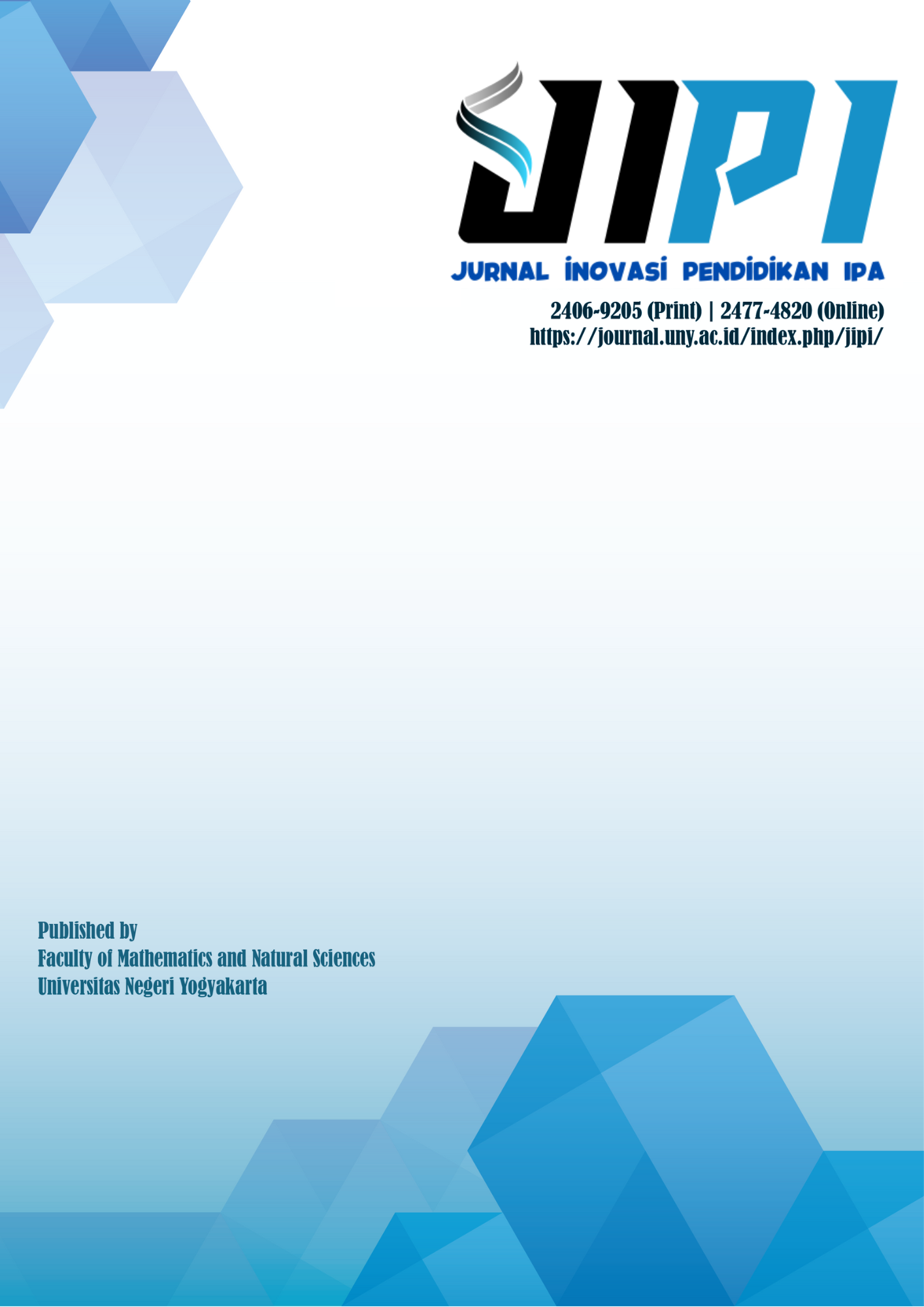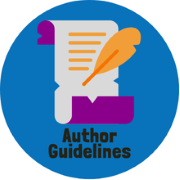Mengembangkan keterampilan berpikir kritis dengan game ritual tumpe
DOI:
https://doi.org/10.21831/jipi.v5i2.25920Keywords:
media pembelajaran, IPA, kearifan lokal batui, berpikir kritis, learning Media, Science, Batui Local Wisdom, Critical ThingkingAbstract
Tujuan penelitian ini mengembangkan produk berupa Game ritual tumpe untuk peserta didik SMP Kelas VII. Penelitian menggunakan metode research and developement (R & D) yang dikembangkan oleh Thiagarajan. Penelitian mengacu pada model 4D: define (mendefinisikan), design (mendesain), develop (mengembangkan) dan disseminate (menyebarluaskan). Hasil penelitian menunjukkan bahwa media pembelajaran yang dikembangkan valid atau memenuhi kriteria kelayakan. Kategori kelayakan yang diperoleh dari ahli media dan juga guru adalah sangat valid. Implementasi media pembelajaran di dalam kelas dapat meningkatkan partisipasi aktif peserta didik sehingga berdampak pada peningkatan kemampuan berpikir kritis. Jenis penelitian menggunakan quasi eksperimen, menggunakan kelas kontrol dan kelas eksperimen. Gain score yang diperoleh pada saat pretest dan posttes pada kelas eksperimen menunjukkan perbedaan yang signifikan. Nilai gain score kelas eksperimen diperoleh 0,67 dan kelas kontrol 0,54 dengan kategori sedang. Efektivitas pembelajaran dilakukan dengan uji Manova dengan perolehan nilai sig. sebesar 0.000 (<0.05). Kondisi tersebut menunjukkan bahwa media yang dikembangkan valid, praktis dan efektif digunakan dalam proses pembelajaran sains di kelas VII SMP.
Develop critical thinking skills with tumpe ritual games
Abstract
The aim of this study was to develop product in the form of a Tumpe Ritual Game for Class VII junior high school students. The research used the research and developement (R & D) method developed by Thiagarajan. The research refers to the 4D model: define, design, develop and disseminate. The result of the study indicates that learning media developed is valid or meet the eligibility criteria. The feasibility category obtained from media experts and also the teacher is highly valid. The implementation of learning media in the classroom can increase students' active participation so that it has an impact on improving critical thinking skill. This type of research uses quasi-experimental, using the control class and the experimental class. Gain scores obtained at the pre-test and post-test in the experimental class showed significant differences. The gain score of experimental class was 0.67 and the control class was 0.54 with the medium category. The effectiveness of learning was done by Manova test with the acquisition of sig values. amounting to 0,000 (<0.05). These condition indicated that the media developed was valid, practical and effective to be used in the process of learning science in class VII SMP.
References
Bakan, U., & Bakan, U. (2018). Game-based learning studies in education journals: A systematic review of recent trends. Actualidades Pedagógicas, (72), 119–145. https://doi.org/10.19052/ap.5245
Barzilai, S., & Blau, I. (2014). Scaffolding game-based learning: Impact on learning achievements, perceived learning, and game experiences. Computers & Education, 70, 65–79. https://doi.org/10.1016/j.compedu.2013.08.003
Chang, C.-Y., Lai, C.-L., & Hwang, G.-J. (2018). Trends and research issues of mobile learning studies in nursing education: A review of academic publications from 1971 to 2016. Computers & Education, 116, 28–48. https://doi.org/10.1016/j.compedu.2017.09.001
Chee, Y. S., Tan, K. C. D., Tan, E. M., & Jan, M. (2012). Learning chemistry performatively: Epistemological and pedagogical bases of design-for-learning with computer and video games. In Issues and Challenges in Science Education Research (pp. 245–262). Dordrecht: Springer Netherlands. https://doi.org/10.1007/978-94-007-3980-2_16
Cicchino, M. I. (2015). Using game-based learning to foster critical thinking in student discourse. Interdisciplinary Journal of Problem-Based Learning, 9(2). https://doi.org/10.7771/1541-5015.1481
Ennis, R. H. (1993). Critical thinking assessment. Theory Into Practice, 32(3), 179–186. https://doi.org/10.1080/00405849309543594
Giannakos, M. N. (2013). Enjoy and learn with educational games: Examining factors affecting learning performance. Computers & Education, 68, 429–439. https://doi.org/10.1016/j.compedu.2013.06.005
Gros, B. (2007). Digital games in education: The design of games-based learning environments. Journal of Research on Technology in Education, 40(1), 23–38. https://doi.org/10.1080/15391523.2007.10782494
Hake, R. R. (1999). Analyzing change/Gain scores. Retrieved from http://www.physics.indiana.edu/~sdi/AnalyzingChange-Gain.pdf
Hao, H., Elvis, M., Civano, F., Lanzuisi, G., Brusa, M., Lusso, E., ... Vignali, C. (2010). Hot-dust-poor type 1 active galactic nuclei in the COSMOS survey. Astrophysical Journal Letters, 724(1 PART 2). https://doi.org/10.1088/2041-8205/724/1/L59
Hong, J.-C., Cheng, C.-L., Hwang, M.-Y., Lee, C.-K., & Chang, H.-Y. (2009). Assessing the educational values of digital games. Journal of Computer Assisted Learning, 25(5), 423–437. https://doi.org/10.1111/j.1365-2729.2009.00319.x
Honiotes, J. (2011). Theories of thematic instruction. Retrieved from http://www.ehow.com/info_8552033_theories-thematic-instruction.html
Kearsley, G. (2010). The theory into practice database.
Lewis-Harris, J. (2010). Personal reflection: A reflection on encouraging critical thinking and empathy: Using so-TL to examine teaching effectiveness in a social justice in graduate education class. International Journal for the Scholarship of Teaching and Learning, 4(1), n1.
Maddux, W. W., Adam, H., & Galinsky, A. D. (2010). When in Rome ... Learn why the romans do what they do: How multicultural learning experiences facilitate creativity. Personality and Social Psychology Bulletin, 36(6), 731–741. https://doi.org/10.1177/0146167210367786
Prasetyo, A. D. (2017). Pengembangan multimedia pembelajaran interaktif mata pelajaran IPA pokok bahasan bumi dan alam semesta kelas VI SD Negeri Ngringin Depok Sleman. E-Jurnal Skripsi Program Studi Teknologi Pendidikan, 6(7), 684–697. Retrieved from http://journal.student.uny.ac.id/ojs/ojs/index.php/fiptp/article/view/8410
Pusat Penelitian Pendidikan Kementerian Pendidikan dan Kebudayaan Republik Indonesia. (2019). Laporan hasil sekolah ujian nasional SMP/MTs.
Rini, R., Tangkas, I. M., & Said, I. (2014). Meningkatkan hasil belajar siswa melalui penggunaan metode demonstrasi pada mata pelajaran IPA di kelas III SDN Inpres Tunggaling. Jurnal Kreatif Online, 2(1). Retrieved from http://jurnal.untad.ac.id/jurnal/index.php/JKTO/article/view/2987
Saptanningtyas, F. Y., & Arifah, H. (2011). Learning using game: alternative strategy to develop critical thingking (Study casus on epsilon game in real analysis learning. In International Seminar and the Fourth National Conference on Mathematics Education 2011 "Building the Nation Character through Humanistic Mathematics Education" (pp. 1–9). Yogyakarta: Universitas Negeri Yogyakarta.
Sari, K. W., Saputro, S., & Hastuti, B. (2014). Pengembangan game edukasi kimia berbasis role playing game (RPG) pada materi struktur atom sebagai media pembelajaran mandiri untuk siswa kelas X SMA di kabupaten Purworejo. Jurnal Pendidikan Kimia, 3(2), 96–104. Retrieved from http://www.jurnal.fkip.uns.ac.id/index.php/kimia/article/view/3717
Suastra, I. W. (2009). Pembelajaran sains terkini: Mendekatkan peserta didik dengan lingkungan alamiah dan sosial budayanya. Singaraja: Universitas Pendidikan Ganesha.
Sukardi. (2009). Metodologi penelitian pendidikan: kompetensi dan praktiknya. Jakarta: PT Bumi Aksara. https://doi.org/2009
Thiagarajan, S., Semmel, D. S., & Semmel, M. I. (1974). Instructional development for training teachers of exceptional children: A sourcebook. Blomington: may be ordered from the Council for Exceptional Children.
Vlachopoulos, D., & Makri, A. (2017). The effect of games and simulations on higher education: a systematic literature review. International Journal of Educational Technology in Higher Education, 14(1), 22. https://doi.org/10.1186/s41239-017-0062-1
Downloads
Published
How to Cite
Issue
Section
Citation Check
License
The authors submitting a manuscript to this journal agree that, if accepted for publication, copyright publishing of the submission shall be assigned to Jurnal Inovasi Pendidikan IPA (JIPI). However, even though the journal asks for a copyright transfer, the authors retain (or are granted back) significant scholarly rights.
Jurnal Inovasi Pendidikan IPA by http://journal.uny.ac.id/index.php/jipi/index is licensed under a Creative Commons Attribution-ShareAlike 4.0 International License.










